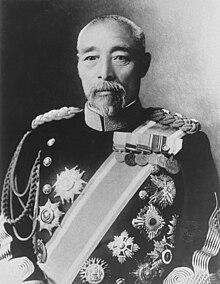|
Oku Yasukata
Count Oku Yasukata (奥 保鞏, 5 January 1847 – 19 July 1930) was a Japanese field marshal and leading figure in the early Imperial Japanese Army. BiographyEarly lifeBorn in Kokura (in present-day Kitakyūshū) to a samurai family of the Kokura Domain in Buzen Province, Oku joined the military forces of the nearby Chōshū Domain during the First and Second Chōshū expeditions and the Boshin War in their struggle to overthrow the Tokugawa shogunate and bring about the Meiji Restoration.[1] Military careerAppointed a commander of the new Imperial Japanese Army, Oku fought against the disgruntled samurai insurgents during the Saga Rebellion of 1871. He was later a survivor of the Taiwan Expedition of 1874. During the Satsuma Rebellion, he defended Kumamoto Castle during its siege as commander of the 13th Infantry Regiment. During the First Sino-Japanese War Oku succeeded General Nozu Michitsura commander of the IJA Fifth Division of the IJA First Army. Later, he successively held posts as commander of the Imperial Guards and Governor-general for the defense of Tokyo. He was elevated to the title of danshaku (baron) under the kazoku peerage system in 1895, and was promoted to army general in 1903.[2] During the Russo-Japanese War, Oku went to the front as commanding general of the IJA 2nd Army and was noted for his role in the Battle of Nanshan, Battle of Shaho, Battle of Mukden, and other campaigns.[3] Oku was awarded the Order of the Golden Kite (1st class) in 1906, and elevated from baron to hakushaku (count) in 1907. In 1911, he received the largely honorary rank of Field Marshal.[4] Oku refused to attend strategy and staff meetings, and thereby gained a reputation for being both a "lone wolf" and also a brilliant tactician capable of independent action. However, Oku's reluctance to attend the staff meetings was due to his partial deafness, and inability to comprehend and contribute to the discussions.[5] Post-war lifeOku had absolutely no interest in politics, and lived in virtual seclusion after the war. When he died of an Intracranial hemorrhage in 1930, many people were astonished, thinking that he had died years previously.[5] Decorations
References
External links
Notes
|
||||||||||||||||||||||||||||||||||||||||||
